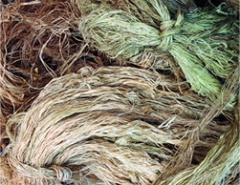Ramie
| Infobox on Ramie | |
|---|---|
| Example of Ramie |  |
| Facts | |
| Origin |
|
| Stowage factor (in m3/t) | - |
| Humidity / moisture | 7,5 - 12% |
| Ventilation | See text |
| Risk factors | See text |
Ramie
Description
Ramie is a flowering plant in the nettle family Urticaceae, native to eastern Asia. It is a herbaceous perennial growing to 1–2.5 m tall; the leaves are heart-shaped, 7–15 cm long and 6–12 cm broad, and white on the underside with dense small hairs—this gives it a silvery appearance; unlike nettles, the hairs do not sting. The true ramie or China grass, also called Chinese plant or white ramie, is the Chinese cultivated plant. A second type, known as green ramie or rhea, is believed to have originated in the Malay Peninsula. This type has smaller leaves which are green on the underside, and it appears to be better suited to tropical conditions.
Ramie is one of the oldest fibre crops, having been used for at least six thousand years, and is principally used for fabric production. It is a bast fibre, and the part used is the bark (phloem) of the vegetative stalks. Ramie is normally harvested two to three times a year but under good growing conditions can be harvested up to six times per year. Unlike other bast crops, ramie requires chemical processing to de-gum the fibre.
Harvesting is done just before or soon after the beginning of flowering. It is done at this time because at this stage there is a decline in plant growth and the maximum fibre content is achieved. Stems are harvested by either cutting just above the lateral roots or else bending the stem. This will enable the core to be broken and the cortex can be stripped from the plant in situ.
After harvesting, stems are decorticated while the plants are fresh. If this is not done while the plants are still fresh the plants will dry out and the bark will be hard to remove. The bark ribbon is then dried as quickly as possible. This will prevent bacteria and fungi from attacking it.
The dry weight of harvested stem from crops ranges from 3.4 to 4.5 t/ha/year, so a 4.5 ton crop yields 1,600 kg/ha/year of dry non-de-gummed fibre. The weight loss during de-gumming can be up to 25% giving a yield of de-gummed fibre of about 1,200 kg/ha/year.
The extraction of the fibre occurs in three stages. First the cortex or bark is removed; this can be done by hand or by machine. This process is called de-cortication. Second the cortex is scraped to remove most of the outer bark, the parenchyma in the bast layer and some of the gums and pectins. Finally the residual cortex material is washed, dried, and de-gummed to extract the spinnable fibre.
Ramie is one of the strongest natural fibres. It exhibits even greater strength when wet. Ramie fibre is known especially for its ability to hold shape, reduce wrinkling, and introduce a silky lustre to the fabric appearance. It is not as durable as other fibres, and so is usually used as a blend with other fibres such as cotton or wool. It is similar to linen in absorbency, density and microscopic appearance. However it will not dye as well as cotton. Because of its high molecular crystallinity, ramie is stiff and brittle and will break if folded repeatedly in the same place; it lacks resiliency and is low in elasticity and elongation potential.
Application
Despite its strength, ramie has had limited acceptance for textile use. The fibre's extraction and cleaning are expensive, chiefly because of the several steps—involving scraping, pounding, heating, washing, or exposure to chemicals. Some or all are needed to separate the raw fibre from the adhesive gums or resins in which it is ensheathed. Spinning the fibre is made difficult by its brittle quality and low elasticity; and weaving is complicated by the hairy surface of the yarn, resulting from lack of cohesion between the fibres. The greater utilization of ramie depends upon the development of improved processing methods.
Ramie is used to make such products as industrial sewing thread, packing materials, fishing nets, and filter cloths. It is also made into fabrics for household furnishings (upholstery, canvas) and clothing, frequently in blends with other textile fibres (for instance when used in admixture with wool, shrinkage is reported to be greatly reduced when compared with pure wool.) Shorter fibres and waste are used in paper manufacture. Ramie ribbon is used in fine bookbinding as a substitute for traditional linen tape.
Shipment / Storage
Ramie is a very fine, soft but strong (strongest natural fibre) and therefore high-quality spinnable fibre. It is pure white and lustrous.
Because it does not rot even when exposed to air and water, it is one of the most important vegetable fibres. This is why clothing exhibiting hardly any damage has been found in ancient pharaohs' tombs, for example.
Well-processed ramie is 99 - 99.5% cellulose, containing in particular no lignin (woody component).
Subject to compliance with the appropriate temperature and humidity/moisture conditions, duration of storage is not a limiting factor as regards transport and storage life.
Ramie is transported in compressed and uncompressed bales, weighing 300 - 400 kg depending on degree of compression.
Raw ramie is generally dispatched unpackaged, while macerated ramie is packaged in jute fabric. The bales are strapped with steel strapping to ensure that they hold together better.
If the product is loaded for shipment in a dry state, it does not have any particular ventilation requirements.
Risk factors
- Self-heating / Spontaneous combustion ((Ramie is assigned to Class 4.1 of the IMDG Code (Flammable solids).
- Odor
- Contamination
- Mechanical influences
- Shrinkage/Shortage
- Insect infestation / Diseases











